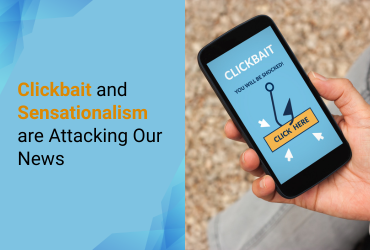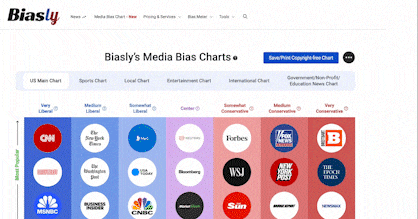
Let’s face it: it’s getting harder and harder to determine if what we read is true. Media sensationalism and clickbait flood the news with attractive content that isn’t always accurate or neutral. Sensationalist journalism has a strong impact on media bias. When outlets focus on gaining attention and engagement numbers, they often lose focus on accuracy and credibility. This makes it much harder to find reliable, unbiased news and be tricked by sensationalist tactics. Luckily, knowing how sensationalism and clickbait show up can help us identify unreliable articles and sources. Let’s examine the features of sensationalism, its impact on the news and its audiences, and how we can address this issue together.
What is Sensationalism?
So, what does “sensationalism” mean? Sensationalism is a journalistic tactic used to get an audience’s attention. It manipulates the readers’ emotions. In the specific case of the news, sensationalism fills what we read with provocative, exaggerated, and sometimes even vulgar information. Humans naturally gravitate towards shocking information. In order to get more viewers, some unethical journalists use this to their advantage.
News that contains sensationalism often comes with characteristics that seriously affect its reliability. One study explained that this kind of journalism “often lacks in-depth investigation and factual basis, relying more on stimulating public curiosity and pandering to low-grade tastes than on providing valuable or constructive information.” In these cases, it can be difficult to parse out what is credible.
Sensationalism is making it much more difficult to find unbiased news sources. If the news only focuses on gaining attention, neutral and factual reporting gets pushed to the side.
How to Identify Sensationalism
Knowing when news reporting is utilizing sensationalism gives you a better idea of the content’s credibility. Articles that use sensationalist tactics tend to share several features in common. Perhaps the most infamous of these is the clickbait headline. Emotionally-charged language, striking visual features, and over-simplified reporting are all very common aspects of sensationalist reporting, as well. Let’s take a look at these characteristics together.
Clickbait Headlines
Clickbait and sensationalism go hand-in-hand. Clickbait occurs when journalists create a headline that is outlandish and shocking enough to prompt users to engage with the work. They often create an inflated sense of urgency. Usually, these headlines are riddled with falsity and dramatics. Sometimes, the actual content of the article doesn’t have much, or even anything, to do with the headline!
The bad thing about clickbait is that it works. Virtually everyone has encountered a clickbait-y headline in this day and age, whether they realized it or not. Research on the effects of clickbait in the USA found that these articles had much higher arousal and curiosity levels in readers than traditional news. This was true even though readers knew their quality was lower. And, unfortunately, interest often wins out over reason. Sensationalism and clickbait are contagious, too. An international study in Spain, Portugal, the USA, and the UK noted that clickbait was the most common kind of news shared on social media.
Clickbait can be hard to identify when the information journalists are reporting on really is surprising. But, most of the time, if the headline seems dramatic or untrue, it’s probably just trying to gain viewership. Take a look at this example of clickbait:

Source: HuffPost
This HuffPost headline nails the balance between creating a sense of shock and urgency, and keeping things vague enough to make you want to know more. The idea that President Donald Trump is in “deep trouble” with a “key group” sounds alarming. But also, refusing to name the key group attracts clicks, makes you wonder– what is the key group? It almost evokes the brand of clickbait headlines like “Doctors Don’t Want You To Know This Big Secret to [Insert Here]!” There’s surprise and intrigue, but not a whole lot of information. Once you read the content of this HuffPost article, you find out that the “key group” is podcasters, and the “deep trouble” is that they disagree with Trump about the Epstein files. There’s something to be said about how losing influencer support may affect Trump’s popularity. However, the headline is not at all designed to relay this information. It is designed to make you click.
Emotionally-Charged Language
Another prominent feature of sensationalism is the use of emotionally-charged language. This is the selection of words and phrases meant to stir up an emotional reaction in the viewer. The information in emotionally-charged news is not necessarily inaccurate. It is, however, influencing the reader to think or feel a certain way. The emotions that journalists will target are often negative ones, like fear or anger. However, all emotions can provoke a reaction.
In cases where journalists emphasized sensationalism over facts, research shows that emotional framing really does affect perception. One analysis of emotionally-charged news affirmed that negatively-framed stories elicit negative responses from audiences. Positively-framed stories elicit emotions like hope and excitement, too, but negative news is more popular. News from hyper-partisan media evoked high numbers of angry reactions in countries like Germany, France, and Belgium. This same study discovered that populist politicians and alternative media in particular use this technique, especially around health issues.
A fascinating study on Russo-Ukrainian war reporting noticed the use of sensationalist language in action. Researchers compared information about the war from Russian and Western sources. The study concluded that Russian sources, presumably with more stake in this issue, made much more frequent use of emotionally-charged language. Notable words that these Russian sources used were “Nazi,” “force,” and “attack.” On the other hand, notable words from Western sources included “report,” “eyewitness,” and location names.
This is a great reminder that sources with inherent bias towards an issue may use these sensationalist tactics more heavily. Imagine a left-leaning outlet on the media bias chart reporting on a topic that greatly affects the left. This reporting could likely be more emotionally-charged than advisable, because they have a predisposed stance on the issue.
Visual Features
Along the lines of emotionally-charged language, sensationalism can include visual aspects of an article. Journalists may sometimes use text features to make their work stand out, instead of quality reporting. These tactics also tend to evoke urgency and outrage. This can take the form of giant text, all-caps titles, bolded headlines, and exclamation points. Just take a peek at this headline from InfoWars:

Source: InfoWars
Images in an article can also convey sensationalist rhetoric. These manipulative pictures tend to have strong emotional associations like alarm, grief, and triumph. The picture from VICE down below is almost creepy. This image, coupled with a negative headline about Shell, gives the reader the impression that something chilling and mysterious is going on in that company. It encourages the viewer to read more, and perhaps view Shell in a threatening way.

Source: VICE
Over-Simplified Reporting
Sensationalism and clickbait boil down intricate issues to very basic storylines. Bias and sensationalism oversimplify the multi-faceted sides to every narrative and complicated context. Pew Research Center reports that more than half of all American journalists believe that not every side deserves equal coverage. There can be good explanations for not giving all perspectives the same coverage. However, it is a fine line to walk. This kind of thinking can quickly lead to the reduction of complex stories in a way that removes all nuance.

Source: Pew Research Center
An analysis of news coverage in the EU discussed 3 framing styles that news outlets use. There’s a “nationalist filter” that emphasizes EU news when a state’s interests are at stake. There’s a “negativity” filter that highlights where negative news about the EU. There is also a “conflict filter.” Journalists may use the conflict filter “when simple conflict lines between states can be drawn at the cost of complex coalitions and often shifting majorities.”
Journalists who rely on sensationalism to promote their work are at a higher risk of this kind of oversimplification. It’s much catchier to frame an issue as “XYZ is bad” or “Person A vs Person B” than to capture its complexities. This practice substantially decreases the quality of the reporting, since you only see one or two sides of the story. Checking both journalist bias analytics and other sources’ framing of a story can give you a better idea of the full picture.
Now, it’s time to check in! Review your understanding of sensationalism by testing yourself with this question:
Which headline is an example of sensationalism? Why?
- Mayor Green proposes a mental health and crisis response team to take over relevant police duties
- ‘Our crisis responses need to change’: Mayor Green announces a shift in police priorities
- Mayor Green’s dangerous new plan wants police to stop responding to victims of domestic violence
Sensationalism’s Impact on the News
Using sensationalism directly impacts the reliability and accuracy of the news. When journalistic focus is on drawing attention and not credibility, bias and misinformation run unchecked.
Side-Taking
Sensationalist media will often “take a side.” To spark outrage or fear, you typically have to be outraged or fearful of someone. When this seeps into the news, we get biased content. One study on political media bias analyzed two different articles that Fox News ran in the 1900s. However, each article was tailored to a different audience. A subsection of the company, Fox Latino, wrote, “In Rare Move, University Grants $22K Scholarship to Undocumented Student.” The general Fox News channel titled this issue “Money for Illegal.” Though these headlines each relay a very different perspective, they employ sensationalist tactics. Additionally, they are both tailored to their audiences and their audiences’ political party stances. In getting their attention, they display one side of the story and produce highly politically biased work.
Sensationalism examples of this variety can be especially evident during national emergencies. In Cameroon, instability throughout the armed conflicts of the Anglophone Crisis resulted in heavily biased news. Research about journalists’ reporting on this topic noted that “the political and cultural leanings of a media house account for sensationalism during crises.” All over the world, where sensationalism is at work, political biases seep into reporting. When you dramatize political issues for views, you run the high risk of inserting a political framing.
Misinformation
It is not uncommon to see media outlets that rely on sensationalism disseminating misinformation. Simplifying political stories and leaving out key voices and context is a breeding ground for falsity. Over the years, researchers have studied the connection between these two things. Examples of sensationalism producing misinformation are especially visible in science journalism. The translation of important scientific reports to theatrical news reports loses a lot of critical background information. This can be dangerous when it comes to reporting on health issues.
After COVID-19, journalism became a key part of relaying studies that may have ramifications for human well-being. Research on science journalism shows that this has resulted in countless inaccuracies. In one case, a study described their research methods in detail in their paper. They used gene editing to modify mice and found correlations between supplements and birth defects. However, reporting in the press stated that these scientists “discovered simply boosting levels of this nutrient during pregnancy can potentially prevent recurrent miscarriages and birth defects.” This drastically overstates the findings and entirely ignores the issues with extrapolating mice research to human solutions. But the more dramatic reporting makes the article seem more important.
Similarly, misinformation on male infertility is widespread. One study discovered that users encounter inaccurate information on male infertility at nearly the same rate as they do accurate information. This study points to sensationalised science journalism shared to social media as a major culprit. To prevent harm to their audience, media outlets are supposed to shoulder the responsibility of accurate reporting. This is why we encourage these outlets to make neutrality and credibility their priority, and encourage readers to assess news reliability with tools like a media bias list.
Consequences of Sensationalist Media
The examples of sensationalism in the news we have explored together have many consequences for our global society. Some of these repercussions operate on a more individual level. For example, sensationalism can affect an individual’s mental health. In times of crisis, like during the COVID-19 pandemic, urgent and panic-inducing headlines significantly increased viewers’ feelings of anxiety and fear. Sensationalism examples in the media can also prompt feelings of distrust towards news as a whole. If misinformation, dramatization, and simplification are so common, viewers may start to feel like no news source is reliable at all.
Sensationalism makes an impact on the larger scale, too. A study on coverage in 2024 found that BBC put out sensationalist coverage of the Iran-Israel conflict in a way that favored Israel. The study concluded that this framing ultimately influenced their audience and policy discourse. In the same vein, conflict framing of Indian and Pakistani relations stoked nationalist flames that resonated with each nation’s audience.
Clickbait and sensationalist media have undeniable impacts on public discourse and processes. When we get news from sources that only show us one perspective to get clicks, our discussions on important topics lack nuance. We have a harder time understanding and empathizing with each other, much less discovering the truth. When our news emphasizes emotional reactivity, our conversations reflect this. We abandon reason and choose to believe whatever aligns with our feelings. If we let sensationalist news warp our opinions, media bias’s influence on elections or even our interpersonal relationships can expand.
Combatting Sensationalism
So, what can we do to combat sensationalism? You’ve already begun taking the first step– improving our media literacy skills. Looking at examples of sensationalism in the media and how they operate helps us catch clickbait and manipulation much more easily. Media literacy education is a highly recommended solution for media bias issues. When we know what tactics are used to trick us, we can make informed decisions about source reliability. When you read articles, especially about inflammatory issues, ask yourself questions like:
- Does this article heavily rely on emotional language?
- Does this article present multiple perspectives?
- Does this article overuse intense visual and text features?
- Does this article appear neutral and accurate (to the best of my knowledge) from the headline to the last sentence?
If you’re looking to begin finding credible information, using a news checker like Biasly’s is a great start. This checker estimates the reliability of and political bias in articles you read. Just install the extension, visit an article on a news website, and click the Biasly icon. In a few seconds, Biasly’s AI-powered Bias Meter will generate a report for the article.
When we educate ourselves, we can intentionally change our news preferences to avoid sensationalism. By not buying into or sharing sensationalist media, we send a message to outlets that clickbait and misinformation are not valuable to us. Instead, engage with ethical and reliable journalism that gives viewers the space to form their own opinions. Only we have the power to change the way we read the news.























